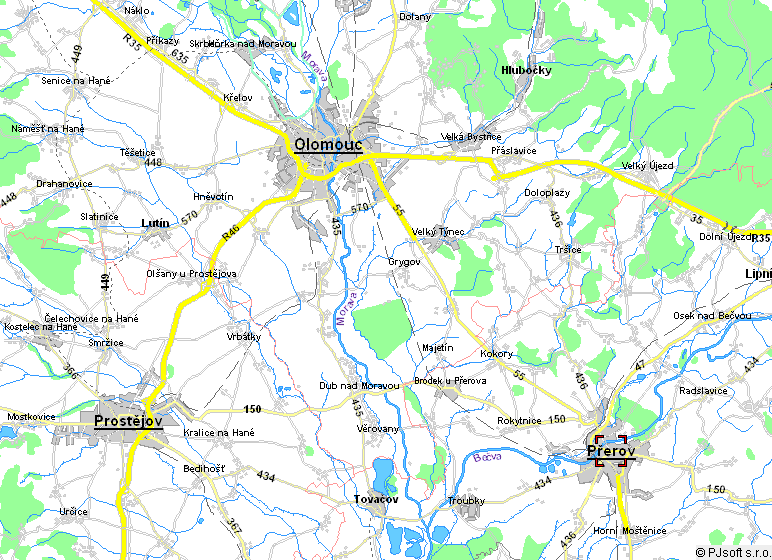
International Conference on Engineering Education and Research
”Progress Through Partnership”
Olomouc and Bouzov Castle, Czech Republic
June 27-30, 2004


|
iCEER 2004
International Conference on Engineering Education and Research ”Progress Through Partnership” Olomouc and Bouzov Castle, Czech Republic June 27-30, 2004 |

|
![]() Organized as an information exchange forum, iCEER-2004 will seek to advance education and research through collaboration, partnership and networking. As our knowledge-based society continues to evolve, paradigms in engineering education are also changing. iCEER-2004 will provide a platform for examining current practice and to plan for the future. We welcome new ideas and proven best practice from around the world.
Organized as an information exchange forum, iCEER-2004 will seek to advance education and research through collaboration, partnership and networking. As our knowledge-based society continues to evolve, paradigms in engineering education are also changing. iCEER-2004 will provide a platform for examining current practice and to plan for the future. We welcome new ideas and proven best practice from around the world.
![]() This international conference will be held at the Bouzov Castle, and in the historical Convent Hall in Olomouc. A pre-conference workshop will be organized in Prague, to deal with the Conference principal theme, “Progress Through Partnership”. The workshop participants will convene in a conference room at the historical compound of the Wallenstein Palace; now the Seat of the Senate of the Czech Republic Parliament. The action will take place under the auspices of the Senator, Vaclav Roubicek, Esq.
This international conference will be held at the Bouzov Castle, and in the historical Convent Hall in Olomouc. A pre-conference workshop will be organized in Prague, to deal with the Conference principal theme, “Progress Through Partnership”. The workshop participants will convene in a conference room at the historical compound of the Wallenstein Palace; now the Seat of the Senate of the Czech Republic Parliament. The action will take place under the auspices of the Senator, Vaclav Roubicek, Esq.
Final report, presented by Prof. Čermák during the Closing Ceremony, includes statistical data and the awarded best papers (click here to get the final report).
January 30, 2004
Abstract submission deadline
February 10, 2004
Notice of acceptance / rejection
March 15, 2004
Deadline for author registration and paper submission deadline to ensure printing and publishing of their papers. Early registration payment.
April 15, 2004
Notice of final acceptance based on peer review. (Registration fees will be refunded if papers are not accepted).
May 21, 2004
Accomodation registration deadline.
All hotel reservations are limited with free accommodation capacities.
Accomodation is organized on the basis, first come, first served. Early payment guarantees your service.
Each abstract will be published in printed Proceedings of Abstracts, each paper will be included in the conference programme and published in the Conference Proceedings on CD-ROM
Every presenter gets 10 minutes to present the paper and additional 5 minutes for a discussion. All conference rooms will be equipped with an overhead projector and a personal computer (Microsoft Windows 2000/XP operating system, PowerPoint 2000/XP programme, USB port, CD-ROM) connected to a data projector (resolution 800x600 points or higher).
Every poster presentation gets a space of 90 cm width x 100 cm height. All papers have to be presented in the poster session by their author(s) according to the conference programme.
Paper template is available in Microsoft Word format as a .doc file (click here to get .doc file) or zipped .doc file (click here to get .zip file ).
You can see all the accepted abstracts in the list of accepted abstracts.
Registration form including hotel reservations is available in MS-Word version (click here to get .doc file, or click here to get a zipped version of .doc file) or printable PDF version (click here to get .pdf file).
Reduced fee (if paid before March 15, 2004):
Includes admission to the workshop, social events, workshop transport, Historical Prague sightseeing tour (Excursion),
bus transfer from Prague to the conference venue, workshop materials and services.
60 EURO - Participant, accompanying person, and others
Workshop fee (if paid after March 15, 2004):
Includes admission to the workshop, social events, workshop transport, Historical Prague sightseeing tour (Excursion),
bus transfer from Prague to the conference venue, workshop materials and services.
100 EURO - Participant, accompanying person, and others
Reduced fee (if paid before March 15, 2004):
Includes printed Proceedings of abstracts, CD-ROM Proceedings including full papers, admission to all sesions,
social events, iNEER book, conference materials and services.
400 EURO - Participant (author, session organizer, committee members),
100 EURO - Accompanying person,
100 EURO - Publication in the Proceedings without participation.
Registration fee (if paid after March 15, 2004):
Includes printed Proceedings of abstracts, CD-ROM Proceedings including full papers, admission to all sesions,
social events, conference materials and services.
450 EURO - Participant (author, session organizer, committee members),
150 EURO - Accompanying person.
All payments for iCEER 2004 symposium can be carried by two ways:
Bank name: CESKOSLOVENSKA OBCHODNI BANKA, A. S.
Bank address:
Information for payment by credit card are available in the Registration form. You can get it in MS-Word version (click here to get .doc file, or click here to get a zipped version of .doc file) or printable PDF version (click here to get .pdf file)..
For easier identification of your payment, please, include the following variable symbol: 930110 and your name in your transfer order. Transfer costs have to be paid by the payer.
Any cancellation requests must be received at ICEER´04 Conference Office in writing form by FAX/MAIL SIGNED LETTER no later than April 30, 2004 to be eligible for a refund of the registration fee. It will be reduced by 35 EUR cancellation fee (administrative bank and manipulation fee) and 95 EUR for iNEER component fee (total 130 EUR). No cancellation refunds will be available after 12:00 p.m. April 30, 2004.
|
|
Pre-conference Workshop - Prague |
iCEER 2004 Conference - Olomouc |
|||||||
|
|
Friday June 25 |
Monday June 28 |
Tuesday June 29 |
Wednesday June 30 |
Thursday July 1 |
||||
|
8:00 |
|
Transfer to Senat |
|
Registration |
|
|
|
||
|
|
|
Security check |
|
|
|
|
|||
|
9:00 |
|
Opening |
|
Opening Ceremony |
|
||||
|
|
|
Workshop meeting |
|
|
|||||
|
10:00 |
|
Transfer to Olomouc |
|
Transfer to Prague (extra payment) |
|||||
|
|
|
|
Coffee break |
Coffee break |
|||||
|
11:00 |
|
Registration |
Coffee break |
Closing Ceremony |
|||||
|
|
|
Coffee break |
|||||||
|
12:00 |
Individual check-in to hotels |
Excursion to Senat |
Lunch |
||||||
|
|
|||||||||
|
13:00 |
Individual programme |
Lunch |
Lunch |
|
|||||
|
|
|
||||||||
|
14:00 |
Excursion to Prague |
Transfer to Prague (extra payment) |
|
||||||
|
|
|
||||||||
|
15:00 |
Transfer to Bouzov Castle |
|
|||||||
|
|
Coffee break |
|
|||||||
|
16:00 |
|
Excursion to Prerov (extra payment) |
|
||||||
|
|
|
Meeting at Bouzov Castle, iNEER Awards Ceremony |
|
||||||
|
17:00 |
Transfer to hotels |
|
|
||||||
|
|
|
|
|
||||||
|
18:00 |
|
|
Dinner |
|
|||||
|
|
|
|
|
||||||
|
19:00 |
|
Buffet lunch |
|
|
|||||
|
|
|
|
|
||||||
|
20:00 |
|
Steering Committee Meeting |
Organ concert Sv. Mořic |
|
|
||||
|
|
|
|
|
||||||
|
21:00 |
|
|
|
|
|||||
|
|
|
|
|
|
|||||
| 8.00-8.30 | Transfer to Senate | |
| 8.30-9.00 | Security Check | |
| 9.00-9.30 | Opening Ceremony - Prof. Roubíček The Knights Hall |
|
|---|---|---|
| Speakers: | ||
| a) President of the Senate: | ||
| b) Ministry of Education, Youth and Sports: | Dr. Petra Buzková | |
| c) VŠB-TU Ostrava: | Dr. Vladimír Kebo | |
| d) iNEER: | Dr. Win Aung | |
| 9.45-11.30 | Workshop - The Government Policy Issues The Horse School |
|
| Speakers: | ||
| a) Rector of Western Bohemia University: | Prof. Josef Průša | |
| b) US Universities: | Dr. John Dunn | |
| c) Rector of VUT Brno: | Prof. Jan Vrbka | |
| d) University of Western Sydney: | Prof. Vojislav Ilic | |
| 11.30-12.00 | Coffee break | |
| 12.00-13.00 | Excursion to Senate | |
| 13.00-14.00 | Walk throught Prague castle gardens | |
| 14.00-17.00 | Excursion to Prague or individual programme | |
| 19.00-21.00 | V.I.P. dinner in Salon 'Tulipan' 200 meters walk from hotel Mövenpick by invitation only |
|
| 8.00-8.45 | Registration, Hotel Flora | |
| 8.30-9.00 | Transfer to Convict | |
| 9.00-10.00 | Opening Ceremony | |
|---|---|---|
| Speakers: | ||
| a) Rector of VŠB-TU Ostrava: | Prof. Tomáš Čermák | |
| b) Ministry of Education, Youth and Sports: | Dr. Jiří Kolář | |
| c) iNEER: | Dr. Win Aung | |
| 10.00-11.00 | Plenary Session A | |
| Speakers: | ||
| a) President of NJIT: | Prof. Robert Altenkirch | |
| b) Vice Chancellor SIU Carbondale: | Prof. John Koropchak | |
| c) Taiwan delegation representative: | Prof. Mu-Lin Lu | |
| 11.00-11.30 | Coffee break | |
| 11.30-12.30 | Plenary Session B | |
| Speakers: | ||
| a) Dr. Chi-Cheng Chang: | The Development of Professional Certification in Taiwan--Some Strategies for Promoting Students’ Professional Capability | |
| b) Dr. Marios Kassinopoulos: | Academic and Professional recognition of UK Engineering Degrees in Cyprus | |
| c) Prof. Gou-Jen Wang: | Toward A Comprehensively Interdisciplinary Nanoscience and Nanotechnology Personnel Training Program | |
| 12.30-14.00 | Transfer to Hotel Flora, lunch | |
| 14.00-15.00 | Poster session, Hotel Flora | |
| 15.30-16.30 | Transfer to Bouzov castle | |
| 17.00-22.00 | Bouzov castle programme | |
Marta Blahova
Contact Address:
VSB- Technical University of Ostrava
iCEER 2004 Conference
17. listopadu 15
Ostrava-Poruba, 708 33
Czech Republic
fax: +420 59 732 1228
email: iceer@vsb.cz
web: http://iceer.vsb.cz
Tomas Cermak, Ostrava CZ (General Chair)
Robert Altenkirch, Newark, NJ, USA
Emmanouel Antonidakis, Chania, Greece
Win Aung, Arlington, VA, USA
Enrique Ballester, Valencia, Spain
Sebastian Bencomo, Madrid, Spain
Juh Wah Chen, Carbondale, IL, USA
Yury Chebotarevsky, Saratov, Russia
Edward Chikuni, Mt. Pleasant, Harare, Zimbabwe
Carlos Brito Cruz, Campinas, Brazil
Gilbert Frade, Paris, France
Denis Gillet, Laussanne, Switzerland
Randy Hinrichs, Redmond, WA, USA
Vojislav Ilic, Sydney, Australia
C.A.C. Imbert, St. Augustine, Trinidad and Tobago
Yury Izhvanov, Moscow, Russia
Ng Wun Jern, Singapore
Wayne Johnson, Palo Alto, CA, USA
Vladimir Kebo, Ostrava, Czech Republic
Robin King, Adelaide, Australia
O. Minayev, Donetsch, Ukraine
Jerzy Moscinski, Gliwice, Poland
Shan-Hwei Ou, Tainan, Taiwan
Vaclav Roubicek, Ostrava, Czech Republic
Hamadou Saliah-Hassane, Montreal, Quebec, Canada
Frode Sandnes, Oslo, Norway
David Shallcross, Melbourne, Australia
George Swisher, Carbondale, IL, USA
Bernardo Wagner, Hannover, Germany
Che-Ho Wei, Taipei, Taiwan
Hong Yi, Nanjing, China
Wojciech Zielinski, Gliwice, Poland
Prof. Petr Noskievic
Ing. Wolfgang Melecky
Dr. Vladimir Kebo
Prof. Zdenek Weiss
Prof. Ivo Vondrak
Dr. Radim Bris
Prof. Jaromír Polak
Prof. Vaclav Roubicek
Prof. Ales Dudacek
Prof. Tomas Cermak
Prof. Vaclav Roubicek
Dr. Vladimir Kebo
Prof. Petr Noskievic
Prof. Lubomir Smutny
Dr. Radim Farana
Prof. Petr Filip
Ing. Andrea Samolejova
Ing. Wolfgang Melecky
Prof. Vladimir Strakos
Ing. Borek Sousedik
Dr. Sarka Vilamova
Mgr. Otilia Drottnerova
Ing. Silvie Sevcikova
Ing. Alice Zelaskova
Dr. Oldrich Kodym
Marta Blahova
The Czech Republic is situated approximately in the geographical centre of Europe and has an area of 78,866 sq. km. It is a landlocked country 326 km away from the Baltic see and 322 km away from the Adriatic. It shares borders with Germany (810 km), Poland (762 km), Austria (466 km) and Slovakia (265 km). The highest point of elevation is the peak of Mt. Snezka (1,602 m above sea level) and the lowest point of elevation is near Hrensko where the River Labe leaves the Czech territory (117 m above sea level).

The three original lands of the Czech Crown are represented on the national seal by three crests:
a lion with two tails representing Bohemia, a red-and-white chequered eagle representing Moravia and a black eagle bearing a silver crescent representing Silesia.
National Anthem: Kde domov můj (Where is my Home)
Area: 78,886 sq.km
Capital: Prague (Praha) (Population: 1 213,800)
Length of state border: 2,303 km
Population: 10 304,302
Population density: 131 inhabitants/sq. km
Time zone: Central European Time (C.E.T.)
Political system: Parliamentary democracy
Currency: Koruna (Kc) - Czech crown (CZK)
1 USD = 26,28 CZK, March 3, 2004
1 EUR = 32,02 CZK, March 3,2004< /p >
Voltage: The line voltage for electricity is 230V 50Hz
Weather: In June, at the time of conference, the temperature usually ranges from 20 degrees of Celsius to 25 degrees of Celsius
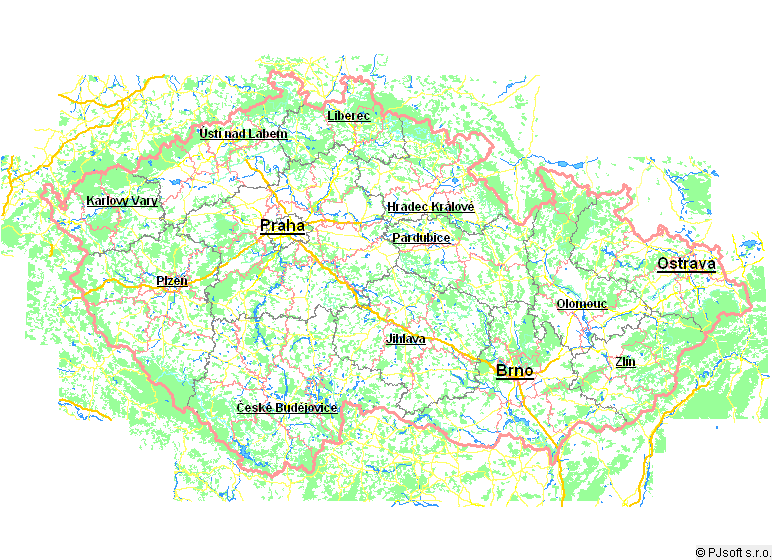
The capital city of the Czech Republic is our most valuable historical city reserve. In 1992 the historical core of the city covering 866 hectares was listed in the UNESCO World Cultural and Natural Heritage Register.
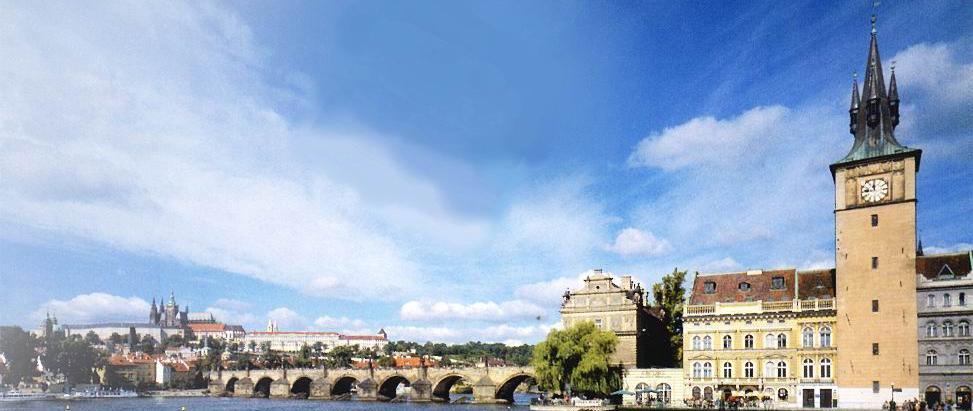
"Praga caput regni" has been inscribed in the Prague´s coat of arms. Since its beginnings Prague has always played an important role in the history of the nation, the country and Europe. Since the Middle Ages Prague has been famous as one of the most beautiful cities of the world, and has been attributed adjectives such as "golden", "hundred-spired", "the crown of the world", "a stone dream". Through many centuries prominent personalities paid homage to it. W. A. Mozart, L. van Beethoven, F. M. Dostojevsky, A. Rodin, G. Apollinaire, P. I. Tchaikovsky, O. Kokoschka and also the British Queen Elizabeth II and Pope John Paul II professed their beguilement by its attractiveness and architectural beauty. The native town is reflected in the works of Jan Neruda, Karel Capek, Jaroslav Hasek, Jaroslav Seifert, Franz Kafka, Max Brod or Egon Erwin Kisch. Prague represents a unique collection of historical monuments dominated by the Prague Castle, which towers high above the city. It is a specimen of all artistic styles and movements. The historical core of the city is situated on both banks of the Vltava River and consists of 6 parts - formerly independent urban units unified in the 18th century. They are as followed: Stare Mesto (Old Town), Josefov (the preserved part of the former Jewish Town - today a part of the Old Town), Nove Mesto (New Town), Mala Strana (Lesser Town), Hradcany and Vysehrad. Naturally, most of the historical monuments, museums and galleries are concentrated right there.
Prague has a lot of hotels, you can choose every of them. We prepared the reservation on these hotels:
Prague has a good international transport connection. Prague international airport is located on the north-west
city edge. For more information, fly schedule etc. go to the Czech Airlines web page http://www.csa.cz.
Transport from/to the airport:
There are several possibilities how to reach the airport: car, bus, taxi or minibus.
Czech Republic has also very good train and bus lines structure. Many of high quality InterCity and EuroCity trains connects Prague with the main European cities. For more information, time schedule etc. go to the IDOS web page http://www.idos.cz/ (Do not be astonished because some of information is in Czech language even on the English pages).
Costs of transport from Prague to Olomouc (conference venue) is included in workshop fee for all workshop participants. It will be served by special busses, which will be arranged at workshop hotels on June 26, 2004 at 10 a.m.
Workshop will be held in the historical building of Senat - Upper Chamber of Parliament of the Czech Republic. Go to the official web page http://www.senat.cz for more information about Senat.

![]()
 The city of Olomouc - The fifth largest city in the Czech Republic and the most beautiful of Moravia, lies in the centre of Moravia. The city of about 100,000 inhabitants situated on the River Morava, is a traditional trade and transport intersection near the Jeseníky Mountains. Olomouc became the natural centre of an area known for centuries as the Haná region. This was a result of its historical significance, its old Palacky University and its cultural and ecclesiastic traditions. A ring of colourful parks and the remains of medieval city walls surround the centre of Olomouc. It was proclaimed a protected reservation area by the state a number of years ago.
The city of Olomouc - The fifth largest city in the Czech Republic and the most beautiful of Moravia, lies in the centre of Moravia. The city of about 100,000 inhabitants situated on the River Morava, is a traditional trade and transport intersection near the Jeseníky Mountains. Olomouc became the natural centre of an area known for centuries as the Haná region. This was a result of its historical significance, its old Palacky University and its cultural and ecclesiastic traditions. A ring of colourful parks and the remains of medieval city walls surround the centre of Olomouc. It was proclaimed a protected reservation area by the state a number of years ago.
 The oldest part of the town now occupies the area, on which formerly stood an eleventh century castle. In its place the royal clan of Premyslovci built in about 1110 the Cathedral of St. Wenceslas. During its last reconstruction, tall spires in the new Gothic style were added to the cathedral. Historically valuable is the town's so-called Romance Palace. Only a wall now remains of the palace with the Romance style, two-part and three-part sectional windows. Their masterful rendition reflects a high level of artistry and craftsmanship.
The oldest part of the town now occupies the area, on which formerly stood an eleventh century castle. In its place the royal clan of Premyslovci built in about 1110 the Cathedral of St. Wenceslas. During its last reconstruction, tall spires in the new Gothic style were added to the cathedral. Historically valuable is the town's so-called Romance Palace. Only a wall now remains of the palace with the Romance style, two-part and three-part sectional windows. Their masterful rendition reflects a high level of artistry and craftsmanship.
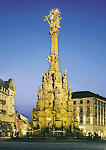 The City Hall, formerly a merchante house, dominates the spacious square. The house underwent adaptations as early as 1378. Following the substantial reconstruction at the beginning of the 17th century, the City Hall changed its appearance several more times, the last time in 1903. An astronomical clock is built into the alcove under the tower spire.
The City Hall, formerly a merchante house, dominates the spacious square. The house underwent adaptations as early as 1378. Following the substantial reconstruction at the beginning of the 17th century, the City Hall changed its appearance several more times, the last time in 1903. An astronomical clock is built into the alcove under the tower spire.
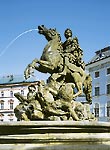 Another prominent feature of the square is the Baroque pillar of the Most Holy Trinity. Vaclav Render designed the stony monument with the exceptionally elaborate figurative decorations. A number of exceptionally valuable buildings have been preserved in the centre of Olomouc. The church of St. Morris draws attention by its massiveness and prismatic spires. It contains an impressive triple-nave gallery and houses a Baroque organ with 10,400 pipes.
Another prominent feature of the square is the Baroque pillar of the Most Holy Trinity. Vaclav Render designed the stony monument with the exceptionally elaborate figurative decorations. A number of exceptionally valuable buildings have been preserved in the centre of Olomouc. The church of St. Morris draws attention by its massiveness and prismatic spires. It contains an impressive triple-nave gallery and houses a Baroque organ with 10,400 pipes.
Preeminent Baroque decorations enrich the interior of the church of St. Michael whose early Gothic predecessor was rebuilt by G. P. Tencalla in 1676-1686. The power of the Jesuit order is reflected in the college buildings and the church of the Immaculate Virgin.
The iCEER Conference will take place in Hotel Flora***, which is the bigest hotel in Olomouc.
Accommodation for all conference participants has been reserved at the hotel Flora. All rooms are
equipped with bath/shower, restroom, telephone, TV with satellite programmes. There are slight diference
in furniture and/or equipment of bathrooms. For more information visit hotel web page http://www.hotel-flora.cz.
All hotel reservations are limited with free accommodation capacities.
Please, fill in the Registration form and send to the conference Executive Secretary.
You can use a MS-Word version (click here to get .doc file, or click here to get a zipped version of .doc file) or printable PDF version (click here to get .pdf file).
Bus transportation for participants of the Prague workshop from Prague to Olomouc (conference venue) is already included in the workshop fee. Buses will depart from the workshop hotels (Mövenpick, Krystal) on June 26, 2004 at 10 a.m.
Olomouc city is very good connected by train and/or bus. Many high quality InterCity and EuroCity trains arrive here from Prague, Ostrava or Wienna. For more information, time schedule etc. go to the IDOS web page http://www.idos.cz/ (Do not be astonished because some of information is in Czech language even on the English pages).
We also prepared a bus transfer to Prague for conference participants on June 30, 2004 or July 1, 2004. This transport is not included in the conference fee.

![]()
 Moravian aristocracy to defend a trade route to Prague founded the Bouzov Castle probably in the early 14th century. The first known owner of Bouzov was the Moravian aristocrat Buz; a written document about him dates from 1317.
Moravian aristocracy to defend a trade route to Prague founded the Bouzov Castle probably in the early 14th century. The first known owner of Bouzov was the Moravian aristocrat Buz; a written document about him dates from 1317.
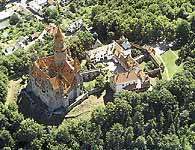 A turning point occurred in the late 17th century, when the castle was sold with a part of the dominion to an order of German knights dominating almost all of northern Moravia. Archduke Eugene Habsburg undertook a significant and extensive renovation and radical reconstruction on the castle (1895-1910). Bouzov turned into a romantic castle.. Architectionically Bouzov was reconstructed on a large scale in the Middle Ages from German Gothic style to Renaissance according to models - south German castles, into a unified organism. Emphasis was laid on artistic decoration.
A turning point occurred in the late 17th century, when the castle was sold with a part of the dominion to an order of German knights dominating almost all of northern Moravia. Archduke Eugene Habsburg undertook a significant and extensive renovation and radical reconstruction on the castle (1895-1910). Bouzov turned into a romantic castle.. Architectionically Bouzov was reconstructed on a large scale in the Middle Ages from German Gothic style to Renaissance according to models - south German castles, into a unified organism. Emphasis was laid on artistic decoration.
 It was mainly the local inhabitants who participated in the reconstruction - bricklayers, stonecutters, woodcutters, etc. Their perfect work still impresses the visitor by a mastered craft and by the capturing the spirit of the past. Copies and modern imitations supplemented the imported paintings, statues, furniture and other furnishings. Late Gothic statues and panel paintings, Renaissance and Baroque furniture, statues and paintings from all over Europe occupy a prominent place.
It was mainly the local inhabitants who participated in the reconstruction - bricklayers, stonecutters, woodcutters, etc. Their perfect work still impresses the visitor by a mastered craft and by the capturing the spirit of the past. Copies and modern imitations supplemented the imported paintings, statues, furniture and other furnishings. Late Gothic statues and panel paintings, Renaissance and Baroque furniture, statues and paintings from all over Europe occupy a prominent place.
Of exceptional historical value are the chapel, knights' hall and assembly hall - these rooms excel by their dimensions and rich decoration.
Bus transportation from Olomouc (conference venue) to the Bouzov castle is included in the conference fee. Buses will depart from conference hotel according to the conference time schedule.
 The town of Prerov is situated in the heart of Moravia along both banks of the Becva River.
Being an social, administrative and cultural centre of the Prerov County, it has a population of
50,000 scattered in twelve town districts. Modern industrial development was triggered by the
railway in 1841, especially engineering, brewing and sugar production. Local power distributor
covered the area with electric networks as early as the end of the l9th century. Then chemistry,
leather goods (the KAZETO Company) and optical instruments (Meopta) followed. Animal breeds have
been shown on the local fairgrounds since 1883. Growing number of companies provide improving
shopping and tourist services and new hotels, private guest-houses and hostels offer accommodation
of good level. Free-time facilities include the swimming-pool, bowling, tennis courts and halls
plus a few more sports facilities. Reconditioning and fitness centres are run by the hotels,
and there are more at the football and winter stadiums and in the facility of the Town Service
Company. Another well-known place is the Bochor Resort some 5 km away, where baths and massages
can be enjoyed or pleasant accommodation booked.
The town of Prerov is situated in the heart of Moravia along both banks of the Becva River.
Being an social, administrative and cultural centre of the Prerov County, it has a population of
50,000 scattered in twelve town districts. Modern industrial development was triggered by the
railway in 1841, especially engineering, brewing and sugar production. Local power distributor
covered the area with electric networks as early as the end of the l9th century. Then chemistry,
leather goods (the KAZETO Company) and optical instruments (Meopta) followed. Animal breeds have
been shown on the local fairgrounds since 1883. Growing number of companies provide improving
shopping and tourist services and new hotels, private guest-houses and hostels offer accommodation
of good level. Free-time facilities include the swimming-pool, bowling, tennis courts and halls
plus a few more sports facilities. Reconditioning and fitness centres are run by the hotels,
and there are more at the football and winter stadiums and in the facility of the Town Service
Company. Another well-known place is the Bochor Resort some 5 km away, where baths and massages
can be enjoyed or pleasant accommodation booked.
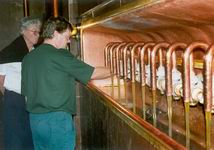 Items worth seeing while in Prerov include the
Upper Square (Horní náměstí) with the château which now harbours the Comenius Museum founded back
in 1888. It shows archaeological, ethnographic, entomological, mineralogical exhibits and items of
the national culture and the life and work of Comenius, including some historic classrooms.
The château courtyard often becomes a stage for concerts. An important role in local cultural
life is plays by the Community House founded on 1 May, 1896 and opened in December 1897.
A complex reconstruction was finished in 1992. It has been the scene of many cultural events,
including the Czechoslovak Jazz Festival organised each September to which top musicians and
bands from Europe and the overseas keep coming. There is a rare steppe locality and Nature
Reserve nearby. Přerovská rokle is where motocross races are staged.
Items worth seeing while in Prerov include the
Upper Square (Horní náměstí) with the château which now harbours the Comenius Museum founded back
in 1888. It shows archaeological, ethnographic, entomological, mineralogical exhibits and items of
the national culture and the life and work of Comenius, including some historic classrooms.
The château courtyard often becomes a stage for concerts. An important role in local cultural
life is plays by the Community House founded on 1 May, 1896 and opened in December 1897.
A complex reconstruction was finished in 1992. It has been the scene of many cultural events,
including the Czechoslovak Jazz Festival organised each September to which top musicians and
bands from Europe and the overseas keep coming. There is a rare steppe locality and Nature
Reserve nearby. Přerovská rokle is where motocross races are staged.
Main information about the Prerov brewery are available on the web page: http://www.zubr.cz.
Bus transportation from Olomouc (conference venue) to the Prerov Brewery is included in the excursion fee. Bus will depart from conference hotel according to the conference time schedule.
